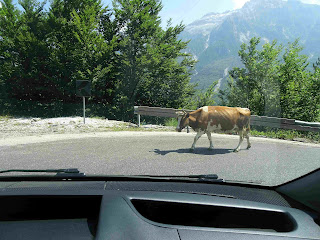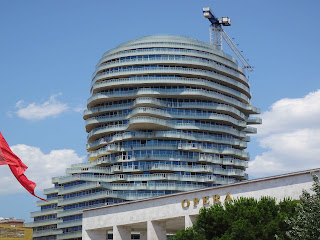I've been collecting food pictures for a second food-centric post and now is the time as Phillip and I finally were able to attend a cooking class yesterday. My earlier food post covered eating and drinking in our first four countries (Italy, Slovenia, Croatia, and Bosnia & Herzegovina), so I'll be starting this one with Serbian food. One of the common and tastiest foods was this simple tomato salad. The tomatoes throughout the Balkans tasted like the ones I grew, real tomatoes, not the cardboard ones from the grocery store. The cheese on the tomatoes was not as tangy as feta but had more flavor and texture than cream cheese. No dressing, just some green onions more as a garnish.
Serbians know how to perfectly cook beef liver as well. We think this was sauteed in salted butter for exactly the right length of time. Delicious (for those who like liver!)
I've shown cevapi, the minced meat uncased sausages in the previous food post, but in Bulgaria, we had the minced meat formed into patties. This was pork, with a different seasoning than cevapi, no cumin flavor in the background. It was served with perfectly crisped sweet potato fries and tzatziki (yogurt, grated cucumber, dill) sauce.
Also in Sofia, we stopped at a cafeteria for lunch. Phillip had a chicken stew and I had Bulgarian moussaka, made with potatoes instead of eggplant but still with the traditional bechamel-type sauce. I ordered beet salad to go with it. The beet salad was grated raw beets so I did need to add some oil and vinegar to make it an actual salad.
On to Skopje, North Macedonia, and back to cevapi. Throughout the Balkans, the cevapi was served with the red avjar sauce and with chopped onions.
and beans and sausage for Phillip:
We didn't spend much time in Prizren, Kosovo, and one of the days we were there was a national holiday, so we were limited to restaurants in the more touristy area. Phillip had pizza, which was just like pizza anywhere. Prizren had restaurants that claimed to serve Mexican food, so I tried their chicken fajitas. It was strips of grilled chicken, onions, and peppers, but they missed on the fajita seasoning. Also, two of those bowl of sauce were mayonnaise-based sauces and the red one was pureed avjar, not salsa. Edible, but certainly not Mexican!
.JPG)
In Montenegro, we had the best desserts in Podgorica, for free. We ate dinner in our hotel because the view from the terrace was so good. We struck up a conversation with the waiter on our arrival day as we were eating early and were his only customers. He had spent several years as a waiter on a Royal Caribbean cruise ship so we had a great time talking with him. He noticed me writing in my journal because I had to move it when he brought my beer. On our final evening, he brought a lady over to speak with us. She was the hotel's general manager. Nice conversation with her, then she left to attend to business and our waiter brought us complimentary desserts from her, apple pie and chocolate cake. Phillip like the chocolate cake, but the apple pie was the standout for me. The texture of the crust was between a flaky American pie crust and the inside of a croissant. The apples were soft but not mushy, flavored with a bit of cardamom along with cinnamon.
.JPG)
In Kotor, we had just one meal that was something different from grilled chicken or a green salad and that was when we made a meal of the appetizer plate. Prosciutto was outstanding as was the tomato. The highlights, however, were the cheeses, especially that scoop of what looks like butter. It was a buttery cream cheese that was delicious on the freshly baked bread.
Moving on to Budva, we again had great hotel food. Phillip ordered chicken and roasted potatoes and got half a chicken! Tender and juicy, bigger than a Cornish game hen, but small enough that he was able to eat it all without having eaten too much food.
Those roasted potatoes that came with his chicken were my favorite so he shared them with me that day. The next time we ate there, I had a caprese roll and a side order of those roasted potatoes. The potatoes were baby Yukon gold (or their version of that), boiled then deep fried with a sweet paprika coating. Crunch exterior, soft inside, perfectly seasoned. And my caprese roll looks like a flour tortilla around tomato and basil. It was not a tortilla; it was a sheet of mozzarella cheese encasing the tomatoes and basil with a balsamic glaze drizzled over the insides before they rolled it.
.JPG)
Now to Albania, the country we are in currently. In Shkoder, we went several times to a restaurant recommended by our hotel staff. Excellent beans and sausage for Phillip, but I ordered the traditional platter consisting of a cabbage roll, a layered pastry-like something (my least favorite on the plate), a stuffed pepper, a stuffed eggplant (my favorite), roasted potatoes and mixed roasted vegetables. The center held a bowl of cheesy, avjar-flavored spread that went well with the veggies.
.JPG)
Another day in Shkoder, we ordered a platter that we shared because it was so much food. Five kinds of meat: sliced smoked sausage, cevapi, a patty of seasoned ground meat, three pieces of grilled chicken, and grilled hot dogs (that tasted just like American hot dogs), cheese, and an entire plate of French fries. Note the black dog to the right of the French fries. He was a good boy who just laid beside the table and thumped his tail on the ground when we spoke to him. He got a few of those hot dogs after we ate our fill of the food.
Here in Tirana, we ate once at our hotel but were not a fan of the food as it seemed greasy. I found a restaurant about a kilometer away that had good reviews, and it lived up to the reviews. Phillip, now a connoisseur of Balkan baked beans, enjoyed their version, made with large lima beans and chunks of sausage.
I ordered a pepper casserole and a pickled cabbage salad. Delicious, but not what I was expecting. The cabbage was a cross between fresh cabbage and sauerkraut (I like both those things). I thought the pepper casserole was red peppers and cheese, until we went to our cooking class yesterday and I learned how the sauce is made. No cheese. More on that when I walk thru the class. The casserole was also delicious.
We looked on-line for a cooking class in each city we visited. I did not find one until here in Tirana, learning to cook three Albanian dishes, a traditional main dish, their version of burek, and a dessert. Eleven students with the others from the Netherlands, Sweden, Scotland, and England. Sindhi, our instructor, spoke excellent English and ensured that all the students were hands-on during the class. She provided unlimited home-made wine (her father makes it at his home in southern Albanian).
.JPG)
We started preparing the main dish, tave kosi, first as it had to cook longest in the oven. Phillip was on meat-chopping duty. Boiled beef, which he is carrying to be covered with sauce. I was on sauce duty, and here's where I learned how to make that traditional sauce that covered the peppers and that will cover this meat. Butter and flour to make a roux, add water from boiling the beef. Add yogurt followed by eggs for thickening it even more. Seasoned with paprika and garlic powder. We whisked the sauce until it came to a boil and thickened, then it was ladled onto the meat in those ceramic dishes, fully covering the meat pieces. As it cooked in the oven, the sauce got even thicker, so it seemed like cheese when finished! One of the students was vegetarian, so we also made a meatless version with red peppers and a different sauce. Phillip got to stir the sauteing peppers.
.JPG)
With the tave kosi in the oven, we worked on the Albanian burek. It did not use filo dough, rather we made the dough ourselves, so it was thicker than filo.
The filling was spinach and cheese. We chopped and cooked the water out of the spinach before adding a feta-type cheese to fill the burek. This is a pie-shaped burek, with the filling between two layers of the dough we made. Phillip is crimping the edges before it went in the oven to bake.
We also made Albanian cookies. Not a lot of sugar in the dough because they were drenched with a cinnamon sugar water solution after baking.
The tave kosi came out of the oven to cool while the burek baked.
When the burek came out of the oven, Sindhi sprinkled each with a bit of water then covered them with a towel to soften the crust.
And our food was all finished, so it was time to eat the fruit of our labors! The tave kosi, with its yogurt-bechamel type sauce, tasted like it was covered with a cheesy sauce. The bowl with red-colored food in it to the left is the vegetarian main dish, red bell peppers in a sauce. All delicious, especially with the wine!
Phillip and I had a great time with a wonderful instructor and really pleasant classmates. We will make the tave kosi at home, but I think I'll find out how to make the northern Balkans burek with the filo dough, as we like that better than Albanian burek.
.JPG)
.JPG)
.JPG)
.JPG)
.JPG)
.JPG)
.JPG)
.JPG)
.JPG)
.JPG)
.JPG)
.JPG)
.JPG)
.JPG)
.JPG)
.JPG)
.JPG)
.JPG)
.JPG)
.JPG)
.JPG)
.JPG)
.JPG)
.JPG)
.JPG)
.JPG)
.JPG)
.JPG)
.JPG)
.JPG)
.JPG)
.JPG)
.JPG)
.JPG)
.JPG)
.JPG)
.JPG)
.JPG)
.JPG)
.JPG)
.JPG)
.JPG)
.JPG)
.JPG)
.JPG)
.JPG)
.JPG)
.JPG)
.JPG)
.JPG)
.JPG)
.JPG)
.JPG)
.JPG)
.JPG)
.JPG)
.JPG)
.JPG)
.JPG)
.JPG)
.JPG)
.JPG)
.JPG)
.JPG)